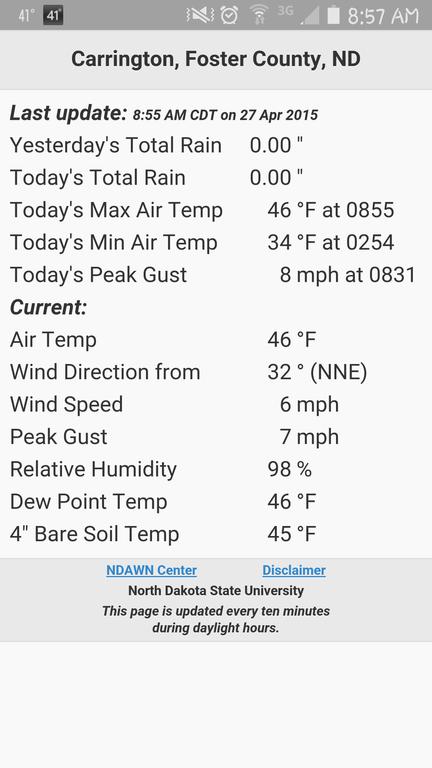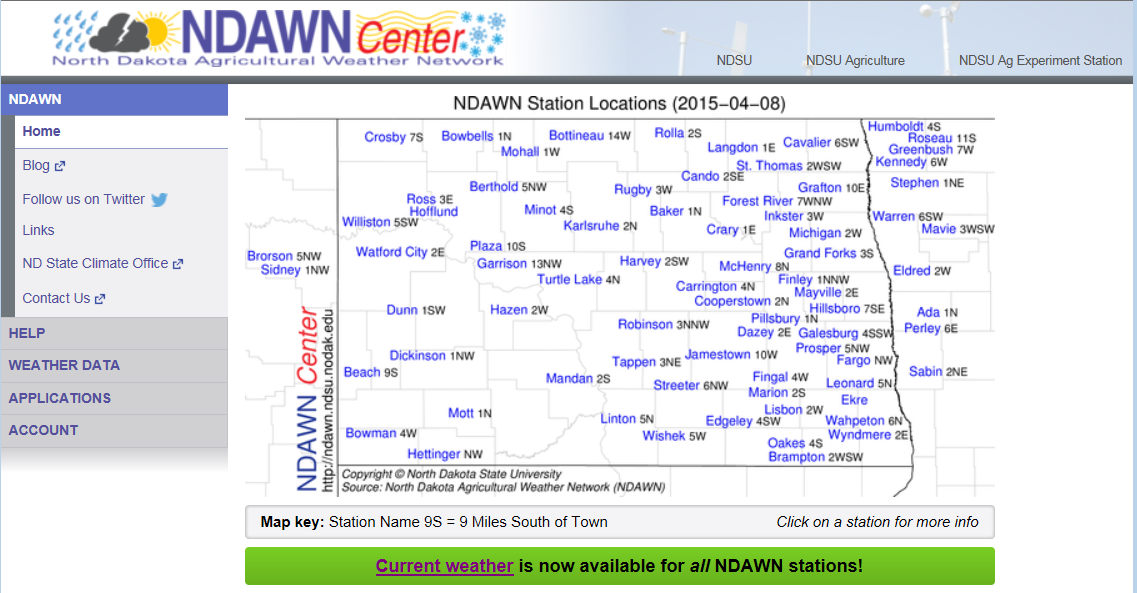Making the most of NDAWN
What’s the weather like around ND?

Instantaneous weather data is available at many sites across North Dakota.
The Carrington REC is a station cooperator for one of 72 NDAWN stations in North Dakota, far western Montana and northeastern Minnesota. As part of the North Dakota Agricultural Weather Network (NDAWN), each monitoring station collects wind speed and direction every five seconds. Air temperature, relative humidity, solar radiation, and soil temperature are measured every 60 seconds. The NDAWN website displays data every ten minutes, but specific intermediate data points are available via online search.

The main NDAWN site at http://ndawn.ndsu.nodak.edu/ displays a map with all of the locations.
Measurements transmitted to the ND State Climate Office (NDSCO) include air temperature, soil temperature, wind speed and direction, rainfall, barometric pressure, relative humidity, and solar radiation. With this information, the NDSCO calculates dew point, potential evapotranspiration, and wind chill, and logs daily minimums, maximums and averages.
Some sites, including Carrington REC, have deep soil temperature probes in addition to standard soil surface and turf monitors.
The NDSCO uses NDAWN data to fuel several agronomical tools such as Growing Degree Day (GDD) calculators, to forecast crop disease potential and insect pressure, and to provide support for estimating crop water use and scheduling irrigation.
Last summer, all of the stations were upgraded from landlines to cellular modems for constant contact with the NDSCO. Technical details on the changeover are available here http://www.ndsu.edu/ndscoblog/?page_id=318 .
Now, anyone with a smartphone or computer can monitor simultaneous NDAWN data from anywhere in the world, free of charge. Detailed instructions for smartphone users who wish to create bookmarks on their device home screen are located at http://ndawn.ndsu.nodak.edu/help-smartphone.html .
Historical records, dating back to 1991 in some cases, can easily be viewed or exported.
The Carrington REC first installed an automated weather station in the summer of 1983 as a research tool. Data storage capacity was limited to one week’s measurements, the unit recorded high and low temperature and precipitation (but not the duration of any trends) and CREC staff had to manually retrieve the data. At that time, data was shared directly with the High Plains Regional Climate Center at the University of Nebraska-Lincoln using a dial-up modem. The following years, the Main Station at Fargo and several other REC’s installed similar weather stations and a weather network was formed in 1989 with the existing six automated weather stations. Later, weather stations sponsored by private and public organizations were formed into the NDAWN network.
We, of course, are partial to the Carrington station, although we also find great value in the NDAWN stations at Linton, Wishek, Oakes, Fingal, and Dazey because of their proximity to many off-station agronomy trials conducted by the CREC.
Linda Schuster
Administrative Secretary


